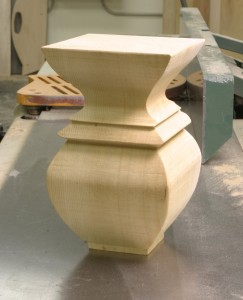We may receive a commission when you use our affiliate links. However, this does not impact our recommendations.
 A couple of days ago, I cut out a form on the band saw and brought it home. I used a big chunk of cedar so it brought with it a nice aroma. I placed it on a bookshelf in the living room because I wanted to live with it for a few days. The basic form wasn’t in question – I liked the lines, transitions and proportions, but I wasn’t sure it fit the overall piece for which it was intended.
A couple of days ago, I cut out a form on the band saw and brought it home. I used a big chunk of cedar so it brought with it a nice aroma. I placed it on a bookshelf in the living room because I wanted to live with it for a few days. The basic form wasn’t in question – I liked the lines, transitions and proportions, but I wasn’t sure it fit the overall piece for which it was intended.
So my 10-year-old son and I were sitting at the table that night, knocking out his homework and talking about his day, when he noticed the piece. He asked me if it was a foot for a piece of furniture and I nodded my head. He regarded it for a few seconds and said, “It’s a very feminine shape.” Of course, I was very proud of the fact that he was able to articulate so well the feeling that the form gave to him. It is a feminine form. But that wasn’t my conscience decision.
I wanted the form to feel substantial and strong with well-proportioned curves, and a nod toward the roofs in Japanese architecture. I don’t remember ever thinking that I wanted to add a feminine element. I didn’t think that because the form had curves that it would throw it into the feminine realm. Does it? Are there masculine forms with curves?
So I got to wondering, is there a proportion of gender related forms that make a piece attractive? Certainly, different aspects of a piece of furniture could be given a masculine, feminine or gender neutral designation. Is there a mixture of these elements that would make an overall form more attractive? I got to thinking about Chippendale chairs, cabriole legs, organic shapes. If a furniture design was decidedly masculine, would it be less attractive than if it had some feminine elements that balanced it out? Does there need to be a balance in design?
By the way, we have a DVD by Charles Brock that deals with some of these issues – you should check out before Woodworking in America 2011 (for which he’s one of our instructors). The DVD is titled, “Shaping A Sculptured Rocker with Charles Brock,” and it would be a great primer if you’re interested in taking in his sessions on sculpting with power and hand tools.
Here are some supplies and tools we find essential in our everyday work around the shop. We may receive a commission from sales referred by our links; however, we have carefully selected these products for their usefulness and quality.








Perusing the pages of another publication I came across just such a notion specifically with regards to ornamentation of the Victorian era. The author used words like pudenda and porta to describe the shapes frequently incorporated in trim work on and in homes of that era. It made since as the Victorian era is one marked by sexual repression and social mores that were somewhat restrictive as compared to us moderns.
Design is made up to two distinct and inseparable features; the positive and negative space. To push one form this way or that is to dance with those two aspects. The final form will always be arguably feminine or masculine as informed by cultural bias.
Just sayin’.
This is interesting, you seem to have a penchant for philiosophic themes in your posts. First Ratios, then Forms. How about Art versus Craft?
Adventures in Editing: http://sundragonediting.com/blog/2009/03/03/conscience-vs-conscious/
I would say that a lot of craftsman, arts & crafts, and some shaker forms seem to have a more masculine form, more from simplicity, weight, and proportion than the straight lines.
I think that if you had a given shape, curved or rectilinear, if you changed the proportions you could shift it from masculine to feminine. Spindly shaker table legs always feel feminine to me.
For instance, in your piece above, if the curved bottom portion was compressed to only be 1/4 of the overall height, it would have a more masculine feel, even though the top is a curved taper.
Unusual sentence from a 10-year old boy.
I think you are correct. Cabriole legs for one are very feminine. They are delicate and the curves are very sensuous. Maybe the masculine elements are reserved for the Roubo style workbench?